Malcolm Morley: The Principal of Uncertainty
It is with great sadness that Border Crossings has learnt of the passing of American artist, Malcolm Morley. To celebrate this seminal artist and his significant body of work, Border Crossings has made available the 2006 interview with Senior Contributing Editor, Robert Enright and Border Crossings Editor, Meeka Walsh.
The following interview was conducted in 2006 and was published in Border Crossings Issue 100, Volume 25 Number 4.
“Every brushstroke is an invention” and “each painting is the first painting I ever made.” Malcolm Morley is an artist who likes to get to the beginning of things. In a career now in its fourth decade, he is admired for his refusal to settle into a style or a way of making art that is predictable. “I wouldn’t want anything I did to look like anything else and I wouldn’t want anything else I’ve done to look like much of what I’m doing now.”
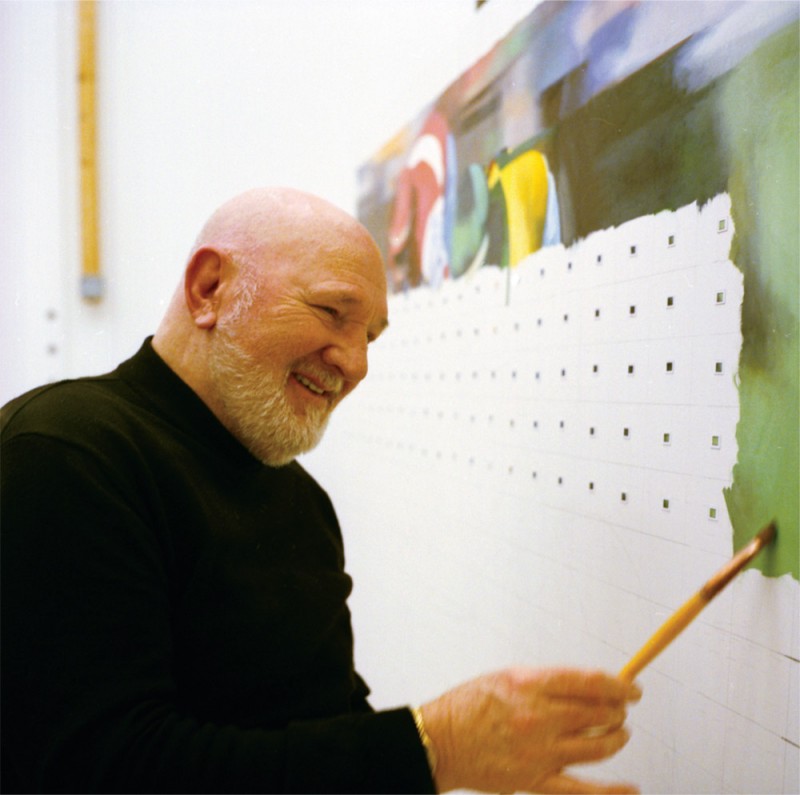
Malcolm Morley, studio shot. Photograph: Daniel Moss.
The British-born painter, who has lived in the United States since 1958, is credited with initiating two influential art movements in the 20th century: Super-realism and Neo-expressionism. In the mid-’60s he dramatically stopped making abstract paintings that showed the mixed influence of Cy Twombly, Willem de Kooning and the West Coast transcendentalism of Mark Tobey in favour of highly realistic paintings. The best known of these are a number of ocean liners, among them SS Amsterdam in Front of Rotterdam, 1966. Apart from a meticulous fidelity to their photographic sources, these works are also remarkable for their method of composition. (It is worth noting that Morley prefers the word fidelity, rather than super-realist, to describe these works). He divided the photographic images into grids, which he then painted square by square and often upside down, making each of these mini-paintings an abstraction. It is a methodology he has continued to use throughout his career.
The details of Morley’s life before coming to America are well-documented. His childhood was troubled: He never knew his birth father, was terrified of his stepfather and drifted into petty crime, culminating in his arrest and three-year sentence to London’s Wormwood Scrubs for break-and-enter. He came out of prison on good behaviour after only two years, a convert to a world he knew nothing about but one which fascinated him. In Scrubs he had read Lust for Life, Irving Stone’s fictionalized biography of Vincent van Gogh. “It looked like something I could do,” he told the critic Jean-Claude Lebensztejn. “I could also be an artist.” From that moment on, Malcolm Morley set out to become his own story.
What he has come to realize, through intensive and lengthy involvement in psychoanalysis, is that the events of his life could be used as material and provocation for events in his paintings. Everything from model shipbuilding as a child, to his experience at sea as an adolescent (he was a galley boy on an ocean-going tugboat crossing to Newfoundland), to bricklaying as a young man, have fed both the content and the process of his art-making. He admits that his consistent use of ships as a subject is connected to the loss of the finest model he ever made; the balsa wood ship was destroyed, along with most of the flat he and his mother were living in, during a German bombing raid on London in 1944. Each time he begins a painting of a boat, he recognizes it as an unattainable attempt to “reclaim that original perfect ship.”
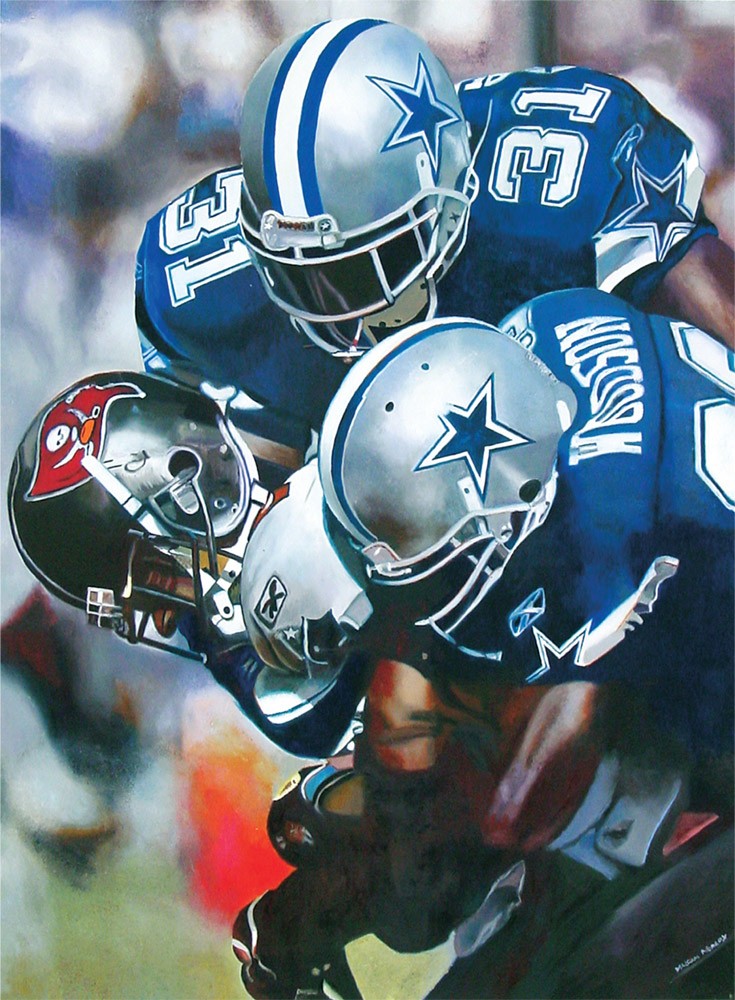
Tackle, 2004, oil on linen, 49 x 36”. All photographs courtesy Sperone Westwater, New York. Private Collection, London.
Morley’s assessment of his own capabilities is as frank and candid as his observations about the world of art and artists. “I always felt that essentially I was very clumsy as a painter, and so there has been this constant battle to be less clumsy.” He couples this aesthetic recognition with a philosophical outlook that rejects the idea of certitude. Morley subscribes to Freud’s observation that you can’t achieve happiness “unless you can tolerate a certain amount of uncertainty.”
One of the ways he guarantees a state of uncertainty is through his cultivation of risk. The essential question he has posed to himself, in a career dominated by highly successful shifts, is to decide what risk he can take that will “disqualify” the success he had achieved in taking the previous risk. This practice of deliberate self-sabotage explains the dramatic changes in the styles and methods of assembling his paintings and accounts for what can be regarded as a process of aesthetic deconstruction. In a sense, he sets out to sink his own ships. Or, put another way, he has taken to heart the advice of Norman O. Brown, the political philosopher who was an early and formative influence on his thinking: “If you want to stay healthy, get lost.” Morley’s career is a sterling example of the generative possibilities of losing oneself in art.
Morley’s painting life is deeply implicated in his lived life, which explains his preference for the visceral over the cerebral. His recent—and startling—foray into politics, what he calls “the state of affairs,” is an example of how far he is prepared to go in his engagement with an unruly and unpopular subject. He has just completed the first image in what may become a body of work, using as its source the troubling photographs that came out of the prison at Abu Ghraib. On a TV screen, which he has placed on top of a camouflaged column, we see an image of the naked prisoners, stacked on top of one another in a humiliating mound of flesh. The stand and the TV are as light as air, but they carry a weight and meaning that is rock solid. “I’ve been looking for a target for a long time,” Morley says about this most recent work in his light-filled studio. It’s clear from this sculpture/painting that he has found a subject that will allow him to zero in on yet another theme of personal significance and social consequence. In setting his sights on a new subject, Malcolm Morley has scored a direct hit on its exposed centre.
Malcolm Morley was interviewed in his studio by Robert Enright and Meeka Walsh on October 16, 2006.
BORDER CROSSINGS: When we were looking at the as yet unnamed painting you’re working on here in the studio, you referred to a sense of democracy in the composition. What did you mean?
MALCOLM MORLEY: What I’m talking about when I mention democracy is that there’s no hierarchy of sensation in the making. You can see the painting in two specific ways: as a holistic thing, and then you can start to experience the parts of it. For me, the essential thing that identifies a work of art—and I’m talking about painting here—is that I can go back and forth on these ways of seeing, in the same ratio as my heartbeat. And that can include Barnett Newman, so it’s not a question of detail, since there’s no detail in Newman. I had a Japanese friend named Tadaski, a great painter who was doing 16- to 20-foot, single-colour paintings back in the ’60s. I said to him, “I bet you can’t find a brush big enough,” and he said, “No I can’t find a brush small enough because I don’t want to miss anything.” He was very Zen. But that idea stuck with me. Also it’s polymorphous, in a sense. Norman O. Brown’s Life Against Death is all about hierarchies and genital organization, and I feel very much in that spirit. I must say, he had a tremendous influence on me in terms of confirming my own views.

S.S. Amsterdam in Front of Rotterdam, 1966, Liquitex on canvas, 62 x 84”. Collection of Irma and Norman Braman.
BC: You’ve said that people should react to painting biologically.
MM: I had a funny idea that it would be great to have a little machine called “The Critic.” You would plug into it and your blood pressure would be registered when you looked at a work of art, then you would get a printout. It was just to demonstrate the idea of not looking at a painting so much with your mind. I’m very interested in those mad ideas of string theory. I read a lot of science books, which is not to say that I understand them all, but here and there things come through. There’s a new direction in microbiology about the source of intelligence. Most people, even if they’re not religious, feel that intelligence trickles down from above. But this other idea is that tiny bits of things become intelligent as they join together. A guide for me is that a thought either excites me or it doesn’t. It’s almost as if a thought from the outside goes to my central nervous system.
BC: Cradle of Civilization with American Woman, 1982, seems to juxtapose a passing world with a more monumental, lasting world. Was that part of the dialectic you wanted to get across as an idea in the painting?
MM: I don’t think about those ideas until after they’re revealed by the painting. I’ve recently come across a book Mark Rothko wrote when he was very young, before he was Rothko, really, and he made the observation that mythology in ancient times was lived on a day to- day basis. It wasn’t something that happened eons ago; it was a living thing. Myths really need heroes, and I started considering this idea of heroes and arrived at those sports figures, because sports stars are the heroes of today. You can go down to the deli and hear two guys, an electrician and a plumber, and they’re recalling a game that was played 10 years ago and they can remember the weather and what happened. So it’s a folklore as well. I’d already started the sports paintings, and then I came across the Rothko notebook. It’s worthwhile, wonderful writing and, of course, all those guys were interested in myths. The other aspect is your acquaintance with, and how you live with art history, as a contemporary artist. Was it Santayana who said that if you don’t know history you’re doomed to repeat it? It is the basis of psychoanalysis of which I am a great proponent. I’m probably the most analyzed person you’ll ever come across—35 years. The basis in Freudian thought, as I understand it, is the problem of repression. Culture conspires to repress, and if you succeed in coming out you have an opportunity to tune in to the world and see how neurotic it is. Norman Brown has a chapter in his book with the title, “The Disease Called Man.”
BC: Do you use psychoanalysis as a functional tool to think about how a painting can be made?
MM: It is connected, and I have a very active dream life. But I would never dream of the idea of making a painting from a dream.
BC: I want to pick up on your relationship to art history. I know that Cézanne was a major influence.
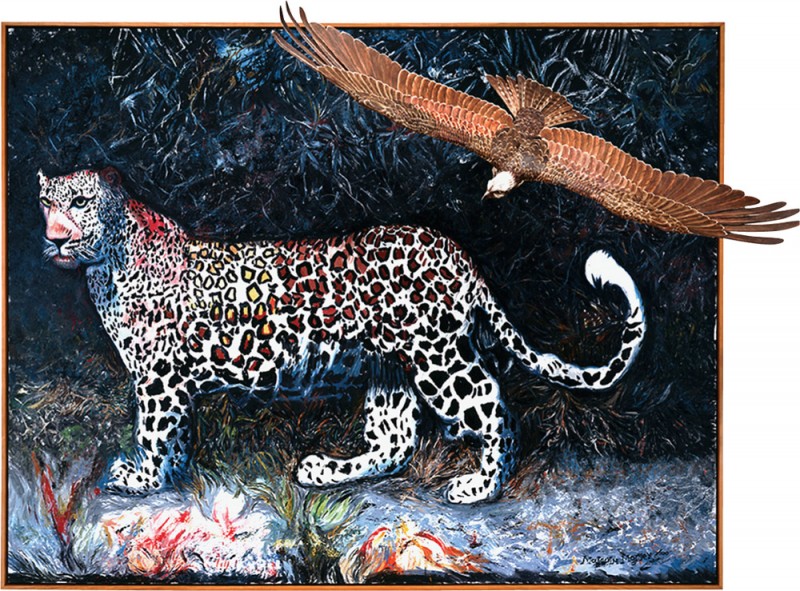
Wildlife, 2000, oil on linen with attached bird, 63 ½ x 84 ½ x 17 3/4” overall, bird wing span: 58”.
MM: The first school I went to, Camberwell School of Art, was very much in that tradition. The tradition was called the Euston Road School, which came out of Walter Sickert, who was the English Cézanne. You’d see dots and dashes, really a scaffolding, and the figure would appear. That was very big at Camberwell. But the way I see it is that the whole history of art is a huge river. So when people ask me how long did it take you to paint that, I’ll say 50,000 years because I’m thinking of a stream from the cave paintings on. It’s a derogatory thing to say, but nevertheless, one can feel the mainstream from which a lot of tributaries go off into swamps and into places where they never get out. They’re not what critic Roger Fry called significant art. It’s very hard to measure how a painter makes a difference. The standard idea is that you’d see passages of paint that would remind you of say, Seurat, but I can’t honestly say that ever happened. I think if I had never come across art history, they still would be the same paintings.
BC: So your relationship to art history is more subliminal?
MM: It’s the essence of those artists that comes through. There was a moment very early on when I was making abstract paintings that were very much pointed towards Twombly and de Kooning, the classic abstract expressionist stance.
BC: When you first went to St. Ives, did you get to know the painters Alfred Wallis and Peter Lanyon?
MM: Wallis had died but I did know Peter Lanyon. I actually got a job carving stones for Barbara Hepworth, until one day I split a big marble down the middle and then I no longer had a job. I was only 17 and I’d just come out of jail. I’d heard that St. Ives was where the artists were. But I never really got on the contemporary artists thing. I met people you probably wouldn’t even know about, good artists who were Royal Academicians, and they took me up. What attracted me tremendously was how friendly artists were to each other, and that meant a great deal because I hadn’t had that sort of experience. So I turned the art world into a family. One of the great things about being an artist is that you can pick your own ancestors.
BC: It doesn’t take too much armchair psychology to imagine that the art world would be compensatory for someone who grew up not knowing who his father was.
MM: I’m sure it was, but I wasn’t conscious of it. I wasn’t very aware. I hadn’t really become myself yet.
BC: How much of your life was shaped by what was a fairly traumatic childhood? A number of critics have argued that your use of ship models in painting came out of the modelmaking you did as a child. Are those legitimate ways of looking at your work?
MM: I think so. I used to make balsa wood models when I was a kid, and my masterpiece was a battleship called HMS Nelson. It had 16-inch guns, the turrets moved and the lifeboats came out. I was to paint it the next day. That night a German doodlebug fell on the house opposite us. We lived on top of a shoe store and my bedroom was facing the street, and the ship was on the windowsill and the whole thing disappeared. All that was left was this gaping hole. Then we became refugee types, billeted with another family, and that was the end of that. Early on in my psychoanalysis, it became clear to me that painting these ships was an attempt to reclaim that original perfect ship, which could never be reclaimed. I would never be able to replace what I call the original loved object. Children have tremendous emotional relationships to objects, like teddy bears. I think that led me to the recognition that nothing could be too much trouble to get it right.
BC: What role did Barnett Newman play in this family of artists you talk about?
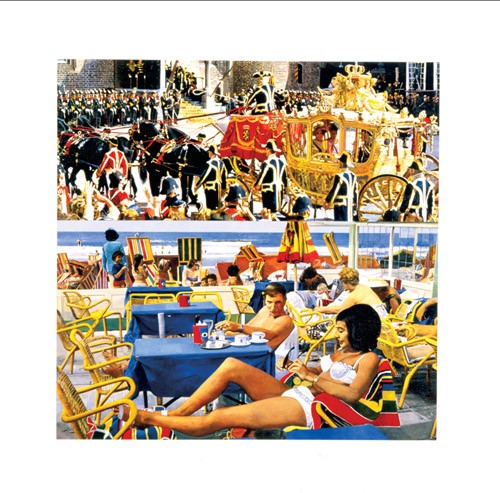
Coronation and Beach Scene, 1968, Magnacolour and Liquitex on canvas, 89 5/8 x 90 1/8”. Hirshhorn Museum and Sculpture Garden, Smithsonian Institution, Washington DC, The Joseph H. Hirshhorn Bequest, 1981.
MM: I met him when I was working in a restaurant called Longchamps. One evening this guy came in wearing a black suit, carrying a cane with a silver head on it, and wearing a monocle. He asked me where I was from, and I said “England,” and he said, “They showed me a wonderful time at the Tate Gallery.” So he gave me his phone number and a week or so later I called him. He actually came down to my studio, which was on Henry Street, and he lived way up on the other side of New York on Riverside Drive. I was doing that Cy Twombly mix with a lot of white painting. When you’re in doubt, use white; although when Robert Ryman was asked why he doesn’t use colour, he said because it would interfere with the painting. I just think that’s a priceless observation. But the first thing Newman said in my studio was that he liked the sense of light in the work, and I thought: “What the hell is he talking about, this is macho painting.” He sat down and said, “all the guys here in New York were involved with the bullfight,” and then he drew himself up to his five-foot-five height and said, “whilst I am interested in the myth of Excalibur, in removing the sword from the stone, in emptying Renaissance space.” Well, I hadn’t come across this scale of thinking, and that’s really what did it. He said the easiest painting in the world to do is a Barnett Newman, except for Barnett Newman. Then you’d ask him something like, “What’s your relationship with Malevich,” and he’d say: “My dialogue is with Michelangelo.” He didn’t mess around.
BC: Was it inspiring as a young artist to hear people talk that way? You mentioned earlier that what you had to do was turn yourself into a legend. From the sounds of it, Newman’s was legendary talk.
MM: Yes, it was quotable and he was inspirational. But it’s not that I sat down and consciously thought about being a legend. It’s just that the kind of things I did became that. A lot of what I did was done out of intense anger.
BC: Anger at the painterly status quo?
MM: It was much deeper but I could fasten this anger on to just about anything. A lot of artists pander to critics and collectors and I thought the best thing to do to a collector is to punch him in the nose right away. It did happen once, and when it got around a lot of the collectors were shit-scared. And that, of course, was the end of Morley. So I tried to destroy myself as much as possible. I love Michelangelo’s way of saying what a piece of sculpture is: You take it to the top of a mountain and roll it down, and what you have left is sculpture. I did that with myself, essentially.
BC: How influential was the show of American art at the Tate Gallery in 1956 in persuading you to come to the United States?
MM: I hadn’t made the connection quite like that, because it took me some time to make contact with the so-called abstract art world, the abstract expressionists and the Cedar Bar and all of that. I was living in Queens and working in Brentano’s bookstore in the Bible and Philosophy section, where I sold a lot of Splengler’s The Decline of the West. For me, history is a very living thing.
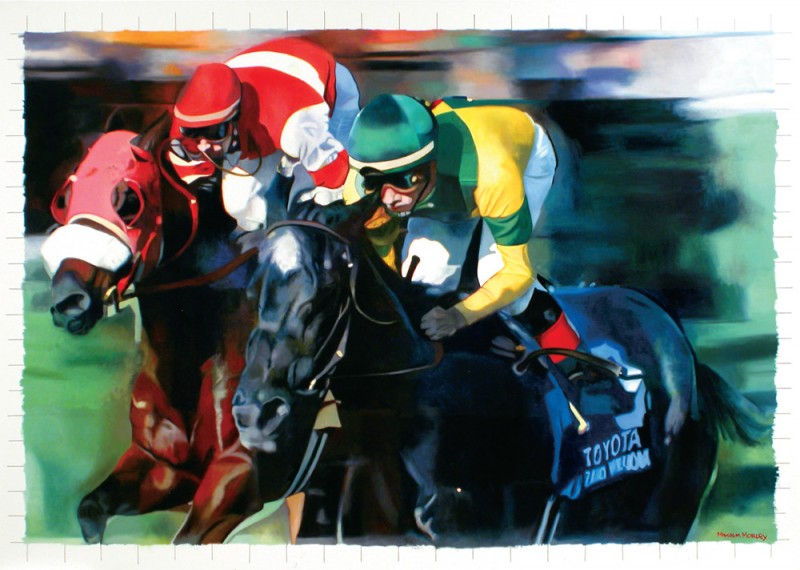
Neck and Neck, 2005, oil on linen, 54 1/8 x 76 5/8”. Private Collection.
BC: Let me use Splengler to ask a question about what a painting does. Does the activity of painting find a way to do the same things differently, or different things the same? Is that the question you end up asking?
MM: I never ask myself that question because each painting is the first painting I ever made.
BC: So you’re Adam in the Garden of Painterly Eden every time you start?
MM: Is that what it’s called? It should be Adam in the Garden of Painting Security.
BC: Did you actually study weaving and bricklaying?
MM: Yes, I did these courses. To me, the wall is the canvas and those grids are the bonding. I’ll tell you a funny story about that. I’d gone through this course and I was coming out of the clink, and they gave me a set of tools, a plumb line and a trowel. I could crack a brick in half with the side of the trowel and I knew all the bonds. We used to build these incredible white-brick- with-black-mortar fireplaces and arches, so they got me a job on a building site and the first thing the foreman said was go and fill up the holes the plumbers had created under these sinks. Although I knew how to build an English arch, I had no idea how to get that bit of brick to stay in that symmetrical hole—it just kept popping out—and at the end of the day the foreman said, “I’m sorry son, I’ve gotta let you go.” Today I get a bang out of how I make the paintings in relation to all that experience.
BC: I want to get at the remarkable changes you went through. You were afraid when you did your first exhibition of realist paintings that Barnett Newman wouldn’t like them. Was it because he was an abstract painter?
MM: Yes. There were areas of me that were naive to a certain degree. Also, you’re not too far off the mark in assuming that abstract painters think figurative painting is a lesser thing. To a certain degree, I agree with them. I feel cursed with the need to make figurative painting.
BC: Except that when you make them, given the nature of your method, every section of every painting is an abstract painting.
MM: Yes. There are a few abstract painters who recognize that. Brice Marden loves them and he’s pretty far from where I am. I despise most figurative artists. Figurative—the word itself pisses me off, as if anything is not a figure.
BC: When you first did the fidelity paintings, they must have been radical.
MM: They were radical paintings. They’ve been called post-pop, which is a term I prefer. Somehow pop had popped. I was quite close to Roy Lichtenstein and I was very involved with the dealer, Ivan Karp. The Coke bottle had been used up, everything had been used up. I can recall going down to Pier 57 with a canvas to paint a ship because ships had been very big in my life. Actually, the other way that had come about was that those abstract paintings were made in horizontal rows—I used a pastry gun to load and scribble into it—and people would say it looked like the superstructure of a liner. I started thinking about that and it led me on. But the problem at the pier was that the end of the ship was over there and the beginning was over here, and it was impossible to grasp it.
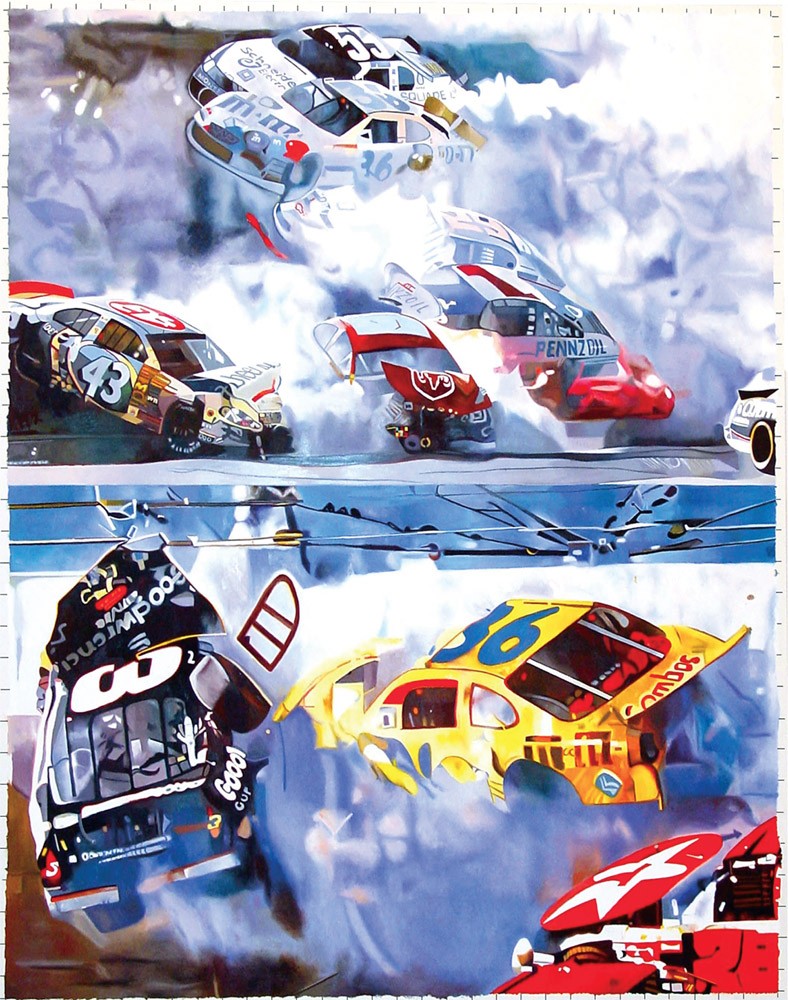
The Art of Painting, 2005, oil on canvas, 101 1/8 x 79 5/8”. Private Collection.
BC: Do you mean perceptually it was too big for your vision to incorporate?
MM: Yes. You’d have to be half a mile away. So I got a postcard of a ship. That was the first one, and oddly enough I made a mistake on the proportion of the grid. The canvas was longer than the proportion of the postcard, and so I just painted a black strip on the right-hand side. It gives a sense of film, which I fell into, so to speak. Also, Richard Artschwager was a big influence. There was a collector from Detroit called Florence Barron and she took me to Richard’s place, and that’s where I saw this grid being used. I was very familiar with the grid from art school, so I connected the two. I felt I could be in the mainstream and still use a grid.
BC: Did it matter to you to be in the mainstream?
MM: Of course. I wanted to be an insider. The most attracting thing to me about art was glory and getting good girlfriends. I found out that women like artists rather than stockbrokers. And also, it was to sit in the pantheon of the greats. Whether or not that happens is something else, but it is the scale of my historical ambition.
BC: So is Vermeer: Portrait of the Artist in his Studio, 1968, an act of homage or an act of competition? If you’re going to enter the pantheon, at what level do you decide to make that entry?
MM: Neither. It was just another way of making a painting. The thing you have to remember is that mine was 10 feet high and the original was something like 25 inches. By then I had met Salvador Dali, which was very interesting, because here was another scale of thinking. He loved Vermeer, who wasn’t thought of very much in the 19th century and in his own time was seen as a copyist. To paint my version I had bought a reproduction of a poster from the Met, and I painted in the photographer’s copyright and “Printed by Abrams” with a border. I had all these theories about borders, that it represents eight horizons instead of four, so it slows down the image in a certain way.
BC: By the time you get to SS Amsterdam in Front of Rotterdam, 1966, you’re painting in a grid system so small you have to use a magnifying glass to do it. A friend of yours is Barnett Newman and “big attack art” is the order of the day; that makes you the “other.”
MM: I knew I was taking risks. Lawrence Alloway did a show at the Guggenheim called “The Photographic Image,” and all of my paintings in the show sold in one afternoon. I was walking down Fifth Avenue with $20,000, 10 [thousand] in each pocket, and I thought: “This occurred by taking a risk, so what would the next-best risk be to disqualify the value of the first risk?” So the collectors panicked and the paintings were sold, sometimes three or four times in a year, and the assumption was I’d lost my way. Ivan Karp thought I’d betrayed him because he’d been going all over the USA showing my slides to art departments, and by the end of the year there were hundreds of guys doing it. Then they began to specialize—racehorses or diners—and so critics would say Morley’s brushstrokes are really ugly when you get them under a magnifying glass. But it was always about painting. Also, working from a postcard is basically still life painting. It’s a three-dimensional object; it has a dimension. I set up still life arrangements with a grid in front of it, so I was playing every way possible with a grid. I’d register how things would shift. As Cézanne said: “I only have to move to the left or the right to find a completely different motif.” So I explored all those things. I was pretty aware of Cézanne’s idea and I was hoping some critics would link it up in some way, but they never have.
BC: Were you consciously setting out to find different ways to keep yourself interested and to keep people guessing?
MM: I never cared about the response of other people. The “other people” was always me, because I’m the doer and I’m also the first spectator. I’m also a spectator I trust. It’s like having an inspector’s number on a shirt that you bought. The dialogue was really with myself. As I’m making every mark I can go through the history of the art in terms of a brushstroke, and every brushstroke represents a thought.
BC: When I look at Coronation and Beach Scene, 1968, it still seems a radical painting.
MM: I never thought it was radical at the time. There was a very famous documentary called The Sky Above, The Mud Below. It was made by the French director Pierre-Dominique Gaisseau, and I think Larry Rivers was involved. That title always attracted me. It was a metaphor, really, for two things being separate, because the sky and the earth are so different.
BC: Tonally, though, the two parts of the painting do share an insistent harmony.
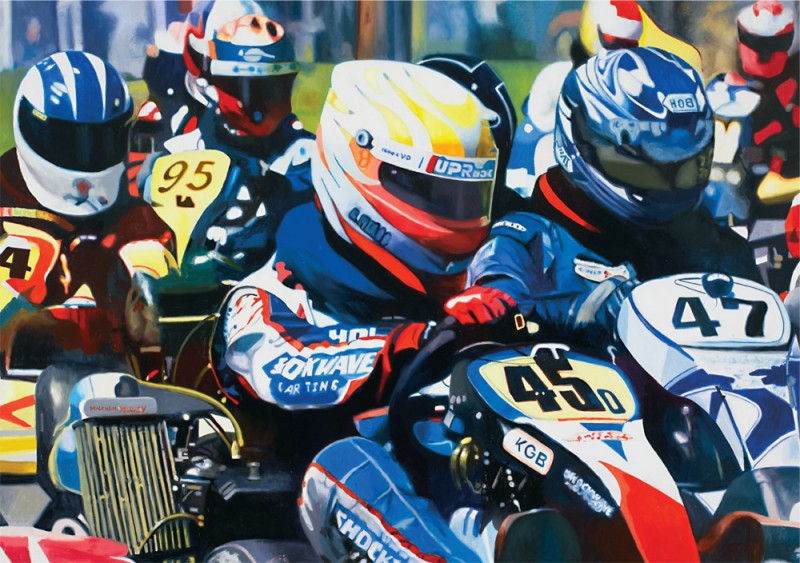
Go Carts, 2006, oil on linen, 32 x 45 ½”. Cartin Collection.
MM: Yes, that was what struck me about it. I think British close tonality has to do with the weather. It rains a lot. The Japanese are also very tonal visually, and it rains a lot there, too. There was never much of a watercolour school coming out of Italy or in Arizona, which I call Aridzone. By the way, English speech is tonal as well. The English are taking letters out of words like mad.
BC: But Coronation and Beach Scene didn’t look like anything else at the time.
MM: No. I wouldn’t want anything I did to look like anything else, and I wouldn’t want anything else I’ve done to look like much of what I’m now doing. If you’re successfully selling one thing, people want you to keep doing it, and when something else comes in, they get upset. But when you see the works in a retrospective, they stay together very well. It’s like a continuum. But they don’t appear in that sequence as they’re being made.
BC: Still, there is a logic to the way you’ve made paintings. There are points where you use your own work as a way of making a self-referential painting.
MM: To start with, nothing makes me decide to do anything. Art has nothing to do with reason.
BC: How much does it have to do with beauty? Does it matter to you whether a painting looks beautiful?
MM: That’s a very tricky question. When I started doing those so-called rough paintings, like The Injuns are Cuming—The Officer of the Imperial Guard is Fleeing, 1983, and Black Rainbow over Oedipus at Thebes, 1988, I almost felt like throwing up at the end of each one. But now I look at them and they look beautiful. Beauty is a learned thing. I always felt essentially I was very clumsy as a painter, so there has been this constant battle to be less clumsy.
BC: Are you getting any better? Or is a better way of putting the question: Are you becoming less clumsy?
MM: Now I welcome clumsy because somehow the hand gets very educated. I don’t trust it. In any case, it’s not really so much to do with the process of doing. If the inspiration is there, the process arrives. Or another version of that is what Cézanne said: If the drawing is right, the inspiration will come.
BC: Is there discovery in the making of the painting for you?
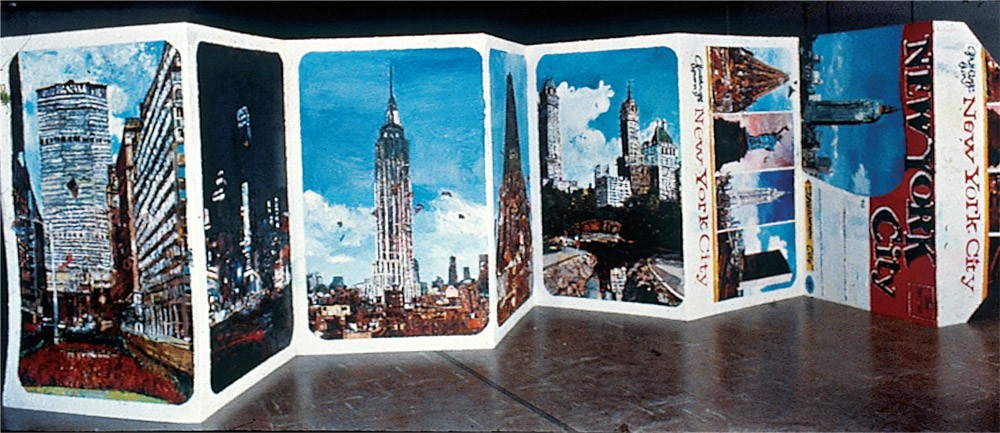
New York City Postcard, 1971, acrylic on canvas, 62 x 234 ½”. Astrup Fearnley Museet for Moderne Kunst, Oslo, Norway.
MM: Yes, I’m discovering I’m making a painting. I mean this painting I’m doing now has a lot weighing on it, so to speak, because it is the first painting I’ve made in a number of years that has been generated from what I call an original image. The other paintings, which were photo-based, I call interpretations, interpretive painting. This is composing from scratch.
BC: Do you still think of painting as a primal activity?
MM: Well, a primal person couldn’t make a painting. It’s necessary to have a tremendously evolved cultural savvy to get to primal painting. There is that great story about Picasso, who was taken around an exhibition of children’s drawing, and at the end of it the director said, “Maestro, what did you think of that?” and Picasso said, “I was astonished, because at their age I could paint like Velasquez and it took me 60 years to learn to paint like a child.”
BC: Do you have to un-invent painting in order to paint now?
MM: For me, every brushstroke is an invention. I can never get it right enough. Picasso’s quote about Cézanne is that he gets hold of a leaf and he’s like a suction cup that won’t let go until he gets on to the next part of the tree. It’s Cézanne’s anxiety to get it right that engages us. Honestly speaking, I can never get skilful enough. As I’ve said, I feel I am rather clumsy.
BC: What made you decide to work from a watercolour source again, rather than from a photographic source as you’d done before? What’s brought you to this point now?
MM: I think I was looking to do something self-generated. And a lot of that had to do with the psychoanalysis, as well.
BC: I was intrigued by The Day of the Locust painting you did in 1977. Was there something about the apocalyptic nature of Nathanael West’s novel that was a point of departure for you?
MM: Yes. One of the opening sentences is that a squadron of dragoons is moving down Wilshire Boulevard. Obviously, they were in a film, but that struck me right away. That’s the second version; originally I’d made a painting of the LA phone book, and I did the tear because that was related to the Duchamp painting Tu m’, 1918. There’s a tear in it and he uses a safety pin. So I build conceits into these paintings.
BC: Is the reading a supplement to the work, or is it something you consciously orchestrate?
MM: It’s nothing that I consciously orchestrate, but I like to learn a lot of things because I feel we’re here to learn. I’m 75, but just recently I hired a math teacher because I have no idea about it, so he comes every Friday and we’re doing fractions and a bit of algebra. He’s brilliant, and because he was educated as a Jesuit, he speaks Greek and Latin. So his teaching of math is rather original. He’ll bring in Shakespeare and we’ll look at sonnets by counting lines in the verse forms. He has a very original way of teaching. The thing I really want to do is geometry.
BC: One of the things American art has always been able to deal with is scale. I’m astonished at the New York City Postcard Foldout, (1972–73). It’s six feet tall and 30 feet long, painted on both sides. Where did the ambition come from to do that piece?
MM: It was like a screen. It appealed to me because one side is upside down when the other side is the right way up, and you can flip them.
BC: I want to give you more credit for invention than you’re prepared to take. You talk as if you just stumble into these things, and yet your career has been a series of deft, intelligent and radical moves, one after another.
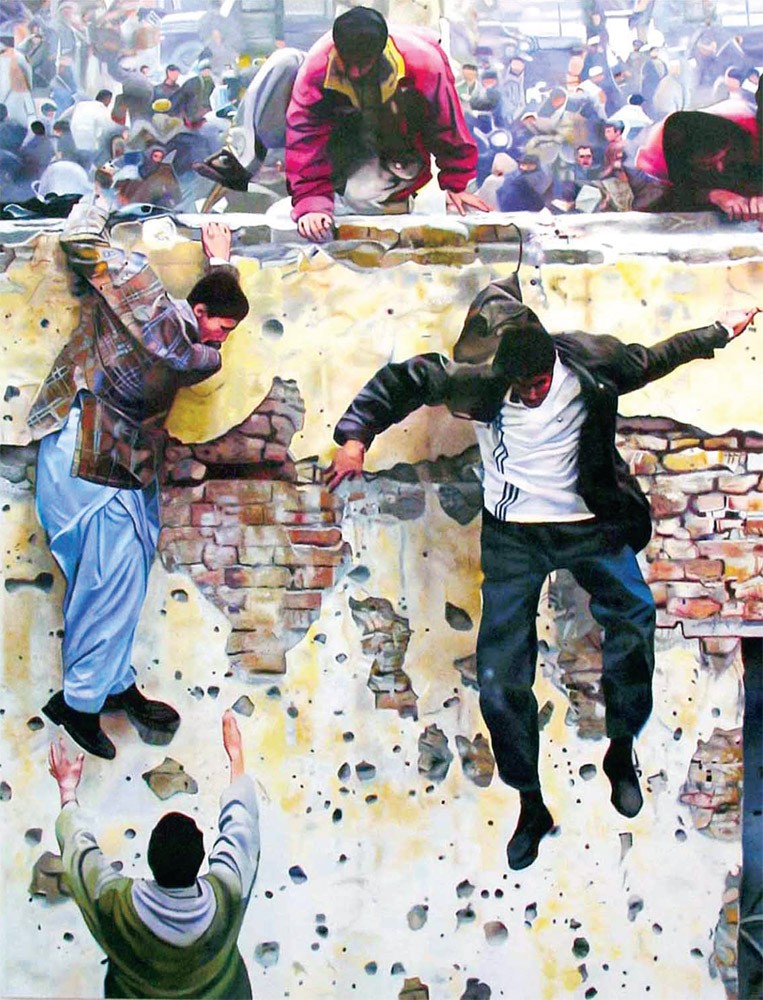
Wall Jumpers, 2002, oil on linen, 90 x 69”. Musee d’Art Moderne et Contemporain de Strasbourg.
MM: Underneath it all I have a tremendous belief in my importance. It’s almost as if I deliberately underplay it. I can’t be like Julian Schnabel and say I’m the most wonderful painter in the world, although I think I think I’m as good as Jasper Johns. I’ve always loved his painting—until I see that it’s become a sort of signature, and that saddens me.
BC: That is one thing you have consistently avoided. The signature for Malcolm Morley would be: I don’t know what the hell he’s going to do next. The signature is uncertainty.
MM: Yes, yes. I love Freud’s observation that you can’t really be happy in the world unless you can tolerate a certain amount of uncertainty. The lengths to which people will go to get rid of uncertainty are extraordinary, even to the point of sacrificing their lives and becoming a clerk and getting a pension. So you’ve got a 30-year-old guy thinking about his retirement. It’s very liberating when you can live without that guarantee. I’m a religious athiest.
BC: Is it because you’re brave, or just foolish?
MM: I think I’m very courageous and I know what I’m doing. Most of the time I’ve been painting in reaction, but now the paintings come out of action, which is more out of loving. Reacting comes out of anger.
BC: But being able to render the image in a pleasing way must be important to you. You’ve said you don’t care what people think, but I can’t entirely buy in to that.
MM: You’re absolutely right, because I think of these paintings very often as eye tests. It’s like going to the optician: what you see and what you don’t see. Now I think that people will be disappointed if I start to make what they would call consistent work-—you know, 20 of those, what happened to him? Because people are excited, and at the same time they don’t want change. It’s that battle of not wanting to change because we know where we are.
BC: Do you pay much attention to what other painters are doing, or is your world sufficiently self-referential that you can generate painting out of what you’ve already done?
MM: That’s been there since the first super-realist painting. I suppose I can say that my identity as an artist was revealed and established with the ocean liners, and that was 30 years ago.
BC: You have initiated two significant art movements on your own. When you look back, do you see yourself in the context of art history, or is that too grand a frame to consider?
MM: That’s where I’m not sure. One never knows. I suppose it is, if you’re thinking of history in such recent terms. You know the story of the French prime minister asking the Chinese prime minister what he thought of the French Revolution, and he said it was too early to tell.
BC: Were you serious, in 1999, when you said you wanted to repaint all your old paintings?
MM: I thought I was at that moment. I think it was a way of repossessing them. It was a way of getting back what I had put out, and some of these paintings had gone for huge sums of money, so somehow the idea had a bit of larceny in it.
BC: William Butler Yeats wanted his letters back so that he could make them consistent with what he felt was his fuller and more mature vision of the world.
MM: I think that’s a cop-out. In a sense, you have to live by what you say. One of the great things about Roy Lichtenstein was he never said anything that could be seen to be contradictory later on. In all the time I knew him, he never said anything negative about any other artist. On the other hand, nobody knew him. He had a screen there that was impenetrable.
BC: I want to talk about the sports paintings. Batter’s Box, 2004, makes me think of Clyfford Still. I suppose I’m thinking of the grounded palette.
MM: You could think of Rothko, too. One of the things I liked about that image was that the players were creating the composition as they played. Those pure white lines at the beginning of the game changed after the players slid over them a few times. You get this wavy composition which you couldn’t possibly invent.
BC: You’ve described Goalie, 2004, as one of your favourite paintings.
MM: I go into such ecstacies over ice and how great it is to paint. And then there are memories I have about Eisenstein’s Alexander Nevsky where all the Swedish knights get caught on the ice and they slowly start to sink. Those abstract white paintings I did were inspired by that particular image. And I used to iceskate myself in a local rink. Ice is such a terrific thing: lemon yellow beside ice and cerulean blue. Then, inside the pads the goalie wears, there is a landscape and a lot of distortion going on. You can really start getting off on all the distortions and reflections.
BC: Has film been an important part of your life?
MM: I am a film buff. I’m sure it gets into my consciousness, but I don’t know how directly it has affected my painting. As a kid I would see three films a week. They used to have an A film and a B film, and I saw all those great B noir films, for which that name did not yet exist. Now it turns out they are the classics and the A films have disappeared.
BC: The painting you did of Jackson Pollock’s floor in 1999 is splendid. What interested you in doing that painting?

Military Object I, 2006, watercolour and museum board sculpture with oil paint on linen, acrylic and enamel paint on paper, sand, magnets, 58 3/16 x 15 ¼ x 18 ¾”.
MM: I went to the Pollock show at MOMA and I took a catalogue which included a reproduction of Pollock’s floor, so I painted it from that reproduction. I’ve never seen his real floor, although later on we went for a visit to Springs in East Hampton. When I saw it, I realized it had absolutely nothing to do with the reproduction. There was no connection and I felt his floor was much better than my painting of it. I think I have to revisit that floor. Very hallucinogenic.
BC: You have talked about “art-on.” Is that what you mean?
MM: What I mean is that if the painting doesn’t have a relationship between its whole and its parts, then it doesn’t work. That can be applied to so-called figurative or abstract painting.
BC: The most astonishing work you’ve done in a long time is the move you’ve made in the Abu Ghraib piece. What made you take that direction?
MM: I’ve been looking for a target for a long, long time. This one seemed to be something I could do something about, because other issues, like the Civil Rights movement, were too abstract. Here’s the thing: For many years I’ve wanted to be engaged in the state of affairs as an artist, but social realism is a dirty word because it mainly means bad art. Yet you can think of Goya’s The Third of May, 1814, which is definitely social realism and a great painting. But I couldn’t find a way into it, and then I developed the idea that the real altar in religion is the TV—it’s the altar of the world, and not just in America. So I found a bridge, a vehicle for doing it, and these were specific images connected directly to a country I’ve become a citizen of. I actually believed in it as a way to organize human beings.
BC: Is part of your outrage that the country you’ve become a citizen of is going down the wrong road?
MM: Yes, but there’s another factor going on here. One of the equations is that the aesthetics of that piece has to outweigh the subject matter. Twenty years from now it will be this object, so it was a challenge on that level. If I say so myself, I think it was a brilliant way of making that statement. I have the idea that I might put sound into it. It would be the sound of men screaming. ■

